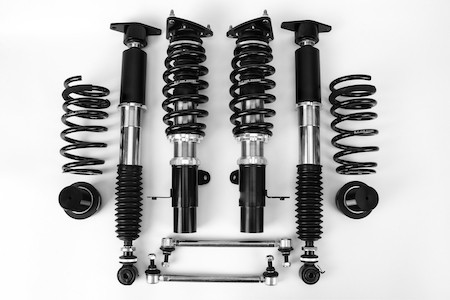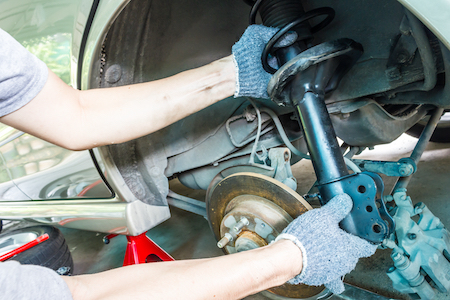What are your plans for this weekend? Heading into the mountains for a day of skiing? Or maybe driving to your favorite trail for a hike?
Living in Denver means you get the best of everything. Mountain adventures, sunny days, snowy escapades, and a vibrant city life, you can experience it all in one day.
But if you’ve driven around town lately, you know it also means one other thing: bumpy, unpredictable roads.
Potholes, rough construction zones, winding mountain drives—your car’s suspension takes a beating. And while your suspension system is designed to handle a lot, it isn’t invincible. Over time, wear and tear can lead to problems you shouldn’t ignore.
How can you tell if your car needs suspension repair? And why does it matter so much, especially here in Colorado? Let’s take a closer look.
Why Your Suspension Matters
What do you think of when someone mentions your car’s suspension system? It’s responsible for more than just a smooth ride. It also:
- Keeps your tires firmly planted on the road for better traction and control.
- Helps absorb shocks from bumps, potholes, and rough terrain.
- Improves steering stability and braking effectiveness.
When the suspension is compromised, it doesn’t just mean a rougher ride. It can also impact your safety, fuel efficiency, and even the longevity of your tires.
In a place like Denver, where road conditions can change dramatically from one block to the next, a healthy suspension is critical.
Common Signs Your Suspension Needs Attention
The good news is that your car usually gives you hints when the suspension system is struggling. You just have to know what to listen and look for.
Excessive Bouncing After Hitting a Bump
If your car keeps bouncing after you drive over a pothole or speed bump, that’s a classic sign your shocks or struts may be worn out.
Normally, your suspension should absorb the impact quickly and stabilize your car. If it feels like you’re riding a pogo stick, it’s time for an inspection.
Nose Dives, Body Leans, or Squatting
Does your car:
- Dive forward when you brake?
- Lean hard to the side when you take a turn?
- Squat backward when you accelerate?
These are all signs that your suspension isn’t properly distributing weight like it should. Worn shocks and struts can’t control the vehicle’s movement, making it less stable—and less safe.
Rough, Jarring Ride
One of the easiest ways to tell if your suspension needs repair is by the way your ride feels.
If every little bump, crack, and pothole feels magnified, or if your teeth chatter every time you hit a rough patch of road, your suspension’s ability to absorb shock is probably compromised.
You shouldn’t feel every flaw in the pavement. If you do, it’s worth getting checked out.
Steering Feels Loose or Drifting
When your suspension is in good shape, your steering should feel tight, responsive, and controlled.
If you find yourself constantly correcting the steering wheel or it feels like the car is drifting even when you’re going straight, it could point to problems with your suspension system—or possibly your alignment, which often goes hand-in-hand.
In any case, it’s not something to ignore.
Uneven Tire Wear
Take a look at your tires. Is the tread wearing down more on one side than the other? Or are there bald spots?
Uneven tire wear often signals that your suspension isn’t holding your vehicle evenly, causing more pressure on certain tires. Left unchecked, it can shorten the life of your tires and create even more suspension and alignment problems down the road.
Oily or Damaged Shocks
Here’s one you can physically check.
Take a look underneath your car (or better yet, have a mechanic do it safely). If you notice that your shocks or struts are greasy or leaking fluid, that’s a red flag.
Shocks need hydraulic fluid to dampen the bumps. If they’re leaking, they can’t do their job—and your suspension’s effectiveness plummets.
How Denver’s Roads Speed Up Suspension Problems
You don’t have to be a car expert to know that Colorado’s driving conditions are rough on vehicles.
- Potholes grow fast thanks to freeze-thaw cycles in the winter.
- Gravel roads and construction sites can kick up debris that damages suspension parts.
- Mountain driving demands more from your steering, braking, and suspension systems with sharp turns, elevation changes, and sudden weather shifts.
All these factors mean that Denver drivers need to stay even more vigilant about suspension health than drivers in milder climates.
What might be “normal wear” elsewhere can turn into serious damage here if you’re not careful.
How Often Should You Check Your Suspension?
There’s no hard-and-fast rule, but most experts recommend inspecting your suspension:
- At least once a year, during a general vehicle checkup
- Anytime you notice warning signs like those listed above
- After a hard impact, such as hitting a large pothole, curb, or being in a minor collision
Regular inspections allow minor problems to be caught early—before they become big, expensive repairs.
What Suspension Repairs Might Include
When you bring your car in because of suspension concerns, one of our mechanics will perform a thorough inspection. Common suspension repairs might include:
- Replacing worn shocks or struts
- Repairing or replacing ball joints
- Replacing bushings that have cracked or deteriorated
- Aligning the wheels to correct handling issues
- Inspecting and tightening steering components
The right solution depends on the specific symptoms and the condition of the components.
Why Trust Us for Your Suspension Repair?
Here in Denver, we know the toll that mountain drives, city potholes, and changing weather can take on your car. That’s why we take suspension repair seriously.
When you bring your vehicle to us, you can count on:
- Thorough inspections tailored to Colorado driving conditions
- Honest assessments and clear explanations of what’s going on
- High-quality parts that restore your vehicle’s performance
- Certified mechanics with years of experience diagnosing and fixing suspension systems
We’re here to help you stay safe on every road—whether you’re cruising downtown or climbing up to Rocky Mountain National Park.
Ready to Keep Your Ride Smooth and Safe?
If your car has been bouncing, drifting, or just feeling a little off, don’t wait until it becomes a bigger problem.
Schedule a suspension inspection with our expert team today. We’ll help you diagnose the issue, recommend the right repairs, and get you back on the road, smoothly and safely.
Because when you’re navigating Denver’s bumpy streets and adventurous mountain roads, you deserve a car that’s ready for it all.










